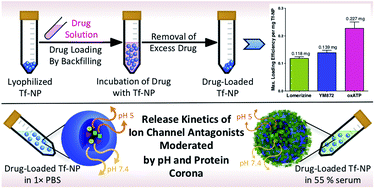Our official English website, www.x-mol.net, welcomes your
feedback! (Note: you will need to create a separate account there.)
Protein corona formation moderates the release kinetics of ion channel antagonists from transferrin-functionalized polymeric nanoparticles
RSC Advances ( IF 3.9 ) Pub Date : 2020-1-15 , DOI: 10.1039/c9ra09523c Priya S R Naidu 1 , Eleanor Denham 2 , Carole A Bartlett 2 , Terry McGonigle 2 , Nicolas L Taylor 1, 3 , Marck Norret 1 , Nicole M Smith 1 , Sarah A Dunlop 4 , K Swaminathan Iyer 1 , Melinda Fitzgerald 2, 4, 5
RSC Advances ( IF 3.9 ) Pub Date : 2020-1-15 , DOI: 10.1039/c9ra09523c Priya S R Naidu 1 , Eleanor Denham 2 , Carole A Bartlett 2 , Terry McGonigle 2 , Nicolas L Taylor 1, 3 , Marck Norret 1 , Nicole M Smith 1 , Sarah A Dunlop 4 , K Swaminathan Iyer 1 , Melinda Fitzgerald 2, 4, 5
Affiliation

|
Transferrin (Tf)-functionalized p(HEMA-ran-GMA) nanoparticles were designed to incorporate and release a water-soluble combination of three ion channel antagonists, namely zonampanel monohydrate (YM872), oxidized adenosine triphosphate (oxATP) and lomerizine hydrochloride (LOM) identified as a promising therapy for secondary degeneration that follows neurotrauma. Coupled with a mean hydrodynamic size of 285 nm and near-neutral surface charge of −5.98 mV, the hydrophilic nature of the functionalized polymeric nanoparticles was pivotal in effectively encapsulating the highly water soluble YM872 and oxATP, as well as lipophilic LOM dissolved in water-based medium, by a back-filling method. Maximum loading efficiencies of 11.8 ± 1.05% (w/w), 13.9 ± 1.50% (w/w) and 22.7 ± 4.00% (w/w) LOM, YM872 and oxATP respectively were reported. To obtain an estimate of drug exposure in vivo, drug release kinetics assessment by HPLC was conducted in representative physiological milieu containing 55% (v/v) human serum at 37 °C. In comparison to serum-free conditions, it was demonstrated that the inevitable adsorption of serum proteins on the Tf-functionalized nanoparticle surface as a protein corona impeded the rate of release of LOM and YM872 at both pH 5 and 7.4 over a period of 1 hour. While the release of oxATP from the nanoparticles was detectable for up to 30 minutes under serum-free conditions at pH 7.4, the presence of serum proteins and a slightly acidic environment impaired the detection of the drug, possibly due to its molecular instability. Nevertheless, under representative physiological conditions, all three drugs were released in combination from Tf-functionalized p(HEMA-ran-GMA) nanoparticles and detected for up to 20 minutes. Taken together, the study provided enhanced insight into potential physiological outcomes in the presence of serum proteins, and suggests that p(HEMA-ran-GMA)-based therapeutic nanoparticles may be promising drug delivery vehicles for CNS therapy.
中文翻译:

蛋白质电晕的形成缓和了离子通道拮抗剂从转铁蛋白功能化聚合物纳米粒子的释放动力学
转铁蛋白 (Tf)-功能化 p(HEMA- ran-GMA) 纳米颗粒被设计为结合和释放三种离子通道拮抗剂的水溶性组合,即佐南帕奈一水合物 (YM872)、氧化三磷酸腺苷 (oxATP) 和盐酸洛美利嗪 (LOM),被确定为继发性退化的有希望的治疗方法神经外伤。再加上 285 nm 的平均流体动力学尺寸和 -5.98 mV 的近中性表面电荷,功能化聚合物纳米粒子的亲水性对于有效封装高水溶性 YM872 和 oxATP 以及溶解在水中的亲脂性 LOM 至关重要。基介质,采用回填法。据报道,LOM、YM872 和 oxATP 的最大负载效率分别为 11.8 ± 1.05% (w/w)、13.9 ± 1.50% (w/w) 和 22.7 ± 4.00% (w/w)。获得药物暴露的估计值在体内,在 37 °C 下,在含有 55% (v/v) 人血清的代表性生理环境中通过 HPLC 进行药物释放动力学评估。与无血清条件相比,已证明血清蛋白不可避免地吸附在 Tf 功能化纳米颗粒表面作为蛋白冠,在 1 小时内阻碍了 LOM 和 YM872 在 pH 5 和 7.4 下的释放速率. 虽然在 pH 7.4 的无血清条件下长达 30 分钟可检测到从纳米颗粒释放的 oxATP,但血清蛋白的存在和微酸性环境损害了药物的检测,可能是由于其分子不稳定性。然而,在有代表性的生理条件下,所有三种药物都从 Tf 功能化 p(HEMA- ran-GMA) 纳米颗粒并检测长达 20 分钟。总之,该研究提供了对血清蛋白存在下潜在生理结果的深入了解,并表明基于 p(HEMA- ran -GMA) 的治疗性纳米颗粒可能是用于 CNS 治疗的有前途的药物递送载体。
更新日期:2020-01-15
中文翻译:

蛋白质电晕的形成缓和了离子通道拮抗剂从转铁蛋白功能化聚合物纳米粒子的释放动力学
转铁蛋白 (Tf)-功能化 p(HEMA- ran-GMA) 纳米颗粒被设计为结合和释放三种离子通道拮抗剂的水溶性组合,即佐南帕奈一水合物 (YM872)、氧化三磷酸腺苷 (oxATP) 和盐酸洛美利嗪 (LOM),被确定为继发性退化的有希望的治疗方法神经外伤。再加上 285 nm 的平均流体动力学尺寸和 -5.98 mV 的近中性表面电荷,功能化聚合物纳米粒子的亲水性对于有效封装高水溶性 YM872 和 oxATP 以及溶解在水中的亲脂性 LOM 至关重要。基介质,采用回填法。据报道,LOM、YM872 和 oxATP 的最大负载效率分别为 11.8 ± 1.05% (w/w)、13.9 ± 1.50% (w/w) 和 22.7 ± 4.00% (w/w)。获得药物暴露的估计值在体内,在 37 °C 下,在含有 55% (v/v) 人血清的代表性生理环境中通过 HPLC 进行药物释放动力学评估。与无血清条件相比,已证明血清蛋白不可避免地吸附在 Tf 功能化纳米颗粒表面作为蛋白冠,在 1 小时内阻碍了 LOM 和 YM872 在 pH 5 和 7.4 下的释放速率. 虽然在 pH 7.4 的无血清条件下长达 30 分钟可检测到从纳米颗粒释放的 oxATP,但血清蛋白的存在和微酸性环境损害了药物的检测,可能是由于其分子不稳定性。然而,在有代表性的生理条件下,所有三种药物都从 Tf 功能化 p(HEMA- ran-GMA) 纳米颗粒并检测长达 20 分钟。总之,该研究提供了对血清蛋白存在下潜在生理结果的深入了解,并表明基于 p(HEMA- ran -GMA) 的治疗性纳米颗粒可能是用于 CNS 治疗的有前途的药物递送载体。











































 京公网安备 11010802027423号
京公网安备 11010802027423号